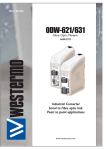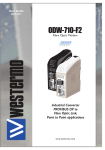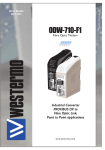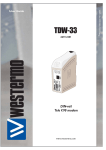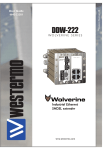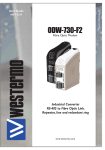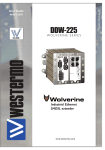Download Westermo 6196-2230 Specifications
Transcript
Users guide 6196-2230 Galvanic Isolation Transient Protection GSM Modem www.westermo.com © Westermo Teleindustri AB • 2004 • REV.A S U 1 0 GD Contents 1. Legal information 2. Description 3. Safety ............................................................................................................................................... 4 .................................................................................................................................................................. 4 5–8 3.1 GSM specific ............................................................................................................................................................ 5 ............................................................................................................................................................................ 3.1.1 General ............................................................................................................................................................ 5 3.1.2 Hospital / Medical environment ................................................................................................... 6 3.1.3 Aircraft ............................................................................................................................................................. 6 3.1.4 Vehicle .............................................................................................................................................................. 6 3.1.5 For Vehicles equipped with an airbag ...................................................................................... 6 3.1.6 Blasting areas .............................................................................................................................................. 6 3.1.7 Explosive atmospheres ........................................................................................................................ 6 3.1.8 RF energy ....................................................................................................................................................... 7 3.1.9 Critical applications ............................................................................................................................... 7 3.1.10 Backup copies .......................................................................................................................................... 7 3.1.11 Antenna care ............................................................................................................................................ 7 3.2 Caution! ...................................................................................................................................................................... 7 3.3 FCC/Industry Canada Notice ................................................................................................................ 8 3.3.1 Statement according to FCC part 15.105 ........................................................................... 8 3.3.2 Statement according to FCC part 15.21 .............................................................................. 8 3.3.3. Statement according to FCC part 15.19 ............................................................................. 8 4. Approvals ....................................................................................................................................................................... 5. Specifications 2 .................................................................................................................................................. 8 9–10 6696-2230 6. Care and Maintenance 7. Installation .......................................................................................................................... 11 12–16 7.1 Mounting / Removal ................................................................................................................................... 12 ................................................................................................................................................... 7.2 SIM card ............................................................................................................................................................... 13 7.3 Antenna care and placement ............................................................................................................. 13 7.4 Connections ............................................................................................................................................ 14–17 7.4.1 Power interface .................................................................................................................................. 15 7.4.2 RS-232 interface, screw terminal ......................................................................................... 15 7.4.3 RS-232 interface, 9-pin D-sub .................................................................................................. 15 7.4.4 Antenna interface ............................................................................................................................. 15 7.4.5 SIM card interface ............................................................................................................................ 15 7.5 LED indicators ................................................................................................................................................ 16 7.6 Quick Start guide ......................................................................................................................................... 17 7.7 Configuration ................................................................................................................................................... 17 7.7.1 Service port .......................................................................................................................................... 17 8. Functional description .......................................................................................................................... 9. GSM network operators, subscriptions and services 10. Glossary .................................. 19 .................................................................................................................................................................... 20 11. Related documents 6696-2230 18 ................................................................................................................................... 21 3 1. Legal information The content of this document are provided “as is”. Except as required by applicable law, no warranties of any kind, either express or implied, including, but not limited to, the implied warranties of merchantability and fitness for a particular purpose, are made in relation to the accuracy and reliability or contents of this document.Westermo reserves the right to revise this document or withdraw it at any time without prior notice Under no circumstances shall Westermo be responsible for any loss of data or income or any special, incidental, and consequental or indirect damages howsoever caused. More information about Westermo can be found at the following internet address: http://www.westermo.com 2. Description The GD-01 US provide a reliable data communication link over GSM networks. The unit has been designed for use in industrial data communication applications and have several features that are not normally present on standard GSM modems. The GD-01 US is a DIN-rail mounted modem with RS-232 interface in either a 9-pin D-sub or in a 5-pin screw terminal. Features: … … … … … … … … … Dual band GSM 850/1900 Mhz GPRS All configurations are done by industry standard AT-commands Serial interface RS-232 D-sub or screw terminal 160 characters SMS DTR-dialing Isolated 12–36 VDC Power supply Din-Rail mountable LED indicators The GD-01 US can be used in data communication applications together with other GSM modems, traditional analogue PSTN modems (like the TD-33) or ISDN adapters (such as ID-90). Packet switched data can be transferred via the GPRS service. 4 6696-2230 3. Safety ! ! ! General: Before using this unit, read this manual completely and gather all information on the unit. Make sure that you understand it fully. Check that your application does not exceed the safe operating specifications for this unit. Before installation, maintenance or modification work: Prevent damage to internal electronics from electrostatic discharges (ESD) by discharging your body to a grounding point (e.g. use of wrist strap). Hazardous voltage may occur within this unit when connected to power supply. Prevent access to hazardous voltages by disconnecting the unit from power supply and all other electrical connections. Installation: This unit should only be installed by qualified personnel. This unit should be built-in to an apparatus cabinet, or similar, where access is restricted to service personnel only. The power supply wiring must be sufficiently fused, and if necessary it must be possible to disconnect manually from the power supply. Ensure compliance to national installation regulations. This unit uses convection cooling. To avoid obstructing the air flow around the unit, follow the spacing recommendations (see Installation section). 3.1 GSM specific Important safety information / operating environment Please read and follow the guidelines listed below.The precautions must be observed during all phases of the operation. Breaking these rules may be dangerous, illegal or affect performance of the unit and/or invalidate the units approval and/or warranty. 3.1.1 General Remember to follow any special regulations and warnings in force in any area and never use the unit whenever it’s forbidden to use it. Do not use the unit when it may cause interference or danger. A wireless device exposed to interference above specified limits could result in deteriorated performance. 6696-2230 5 3.1.2 Hospital / Medical environment Do not use the unit in a medical environment such as health care facities. Follow any regulations or rules that instruct you to not use the unit. Medical equipment may be sensitive to RF energy. If the unit is being used together with any medical devices (such as pacemakers, hearing aids, etc.) consult the physician and/or the manufacturer of the device to determine if it is adequately shielded from external RF energy. 3.1.3 Aircraft Do not use the unit in an aircraft.The use of a wireless unit in an aircraft may be dangerous to the operation of the aircraft, disrupt the wireless network, and may be illegal. Failure to observe these instructions may lead to suspension or denial of cellular services to the offender, legal action, or both. 3.1.4 Vehicle If the unit is incorrectly installed in a vehicular environment, the operation of the unit could interfere with the vehicle electronics. Faulty installation and/or operation can constitute a safety hazard. 3.1.5 For Vehicles equipped with an airbag An air bag inflates with great force. DO NOT place objects, including either installed or portable wireless equipment, in the area over the air bag or in the air bag deployment area. If in-vehicle wireless equipment is improperly installed and the air bag inflates, serious injury could result. 3.1.6 Blasting areas Do not use the unit where blasting is in progress or in “blasting areas”. Observe restrictions and follow any regulation or rules. 3.1.7 Explosive atmospheres Do not use the unit in any area with a potentially explosive atmosphere. Potentially explosive areas are often, but not always, clearly marked. They include fuelling areas such as petrol stations, below decks on boats, fuel or chemical transfer or storage facilities, and areas where the air contains chemicals or particles, such as grain, dust, or metal powder. 6 6696-2230 3.1.8 RF energy The GD-01 US is a low power radio transmitter and receiver. When it is ON, it receives and also sends out radio frequency (RF) signals. Most modern electronic equipment is shielded from RF signals. However, certain electronic equipment may not be shielded against the RF signals from your wireless unit. All radio transmitting devices send signals which may cause interference in different electronic devices.To avoid interference, place the units antenna on a sufficiently long distance from other electronics. 3.1.9 Critical applications Cellular units operate using radio signals and cellular networks cannot be guaranteed to connect in all conditions.Therefore you should never rely solely on a wireless device for essential communications, for example medical emergencies. 3.1.10 Backup copies Remember to make backup copies of all important data, for example PIN/PUK codes, contents of SIM card etc. 3.1.11 Antenna care Use only the supplied or an approved replacement antenna. Unauthorized antennas, modifications, or attachments could damage the unit and may violate FCC regulations. Do not touch the antenna unnecessarily when the unit is in use. Contact with the antenna affects call quality and may cause the unit to operate at a higher power level than otherwise needed. The antenna connected to the unit is a magnetic mounted antenna with 0 dBd gain. Using this antenna the total composite power in PCS mode is smaller than TBD watt ERP. The antenna used for this mobile transmitter: Part Number 3193-9047 Description MiniMag Dual Band Gain 0 dBd Frequency range [MHz] 824–894, 1710–1880, 1850–2170 3.2 Caution! In order to comply with FCC RF exposure requirements, install the GD-01 US and its antenna so that a minimum distance of 20 cm (8 inches) can be maintained between the antenna in use and all persons.The antenna used for this mobile transmitter must not be co-located or operating in conjunction with any other antenna or transmitter. 6696-2230 7 3.3 FCC/Industry Canada Notice 3.3.1 Statement according to FCC part 15.105 NOTE: This equipment has been tested and found to comply with the limits for a Class B digital device, pursuant to Part 15 of the FCC Rules.These limits are designed to provide reasonable protection against harmful interference in a residential installation.This equipment generates, uses and can radiate radio frequency energy and, if not installed and used in accordance with the instructions, may cause harmful interference to radio communications. However, there is no guarantee that interference will not occur in a particular installation. If this equipment does cause harmful interference to radio or television reception, which can be determined by turning the equipment off and on, the user is encouraged to try to correct the interference by one or more of the following measures: • Reorient or relocate the receiving antenna. • Increase the separation between the equipment and receiver. • Connect the equipment into an outlet on a circuit different from that to which the receiver is connected. • Consult the dealer or an experienced radio/TV technician for help. 3.3.2 Statement according to FCC part 15.21 Modifications not expressly approved by Westermo could void the user's authority to operate the equipment. 3.3.3. Statement according to FCC part 15.19 This device complies with Part 15 of the FCC Rules. Operation is subject to the following two conditions: (1) this device may not cause harmful interference, and (2) this device must accept any interference received, including interference that may cause undesired operation. 4. Approvals EMC: FCC part 2, 15, 22 and 24 Network: PTCRB Safety: UL 60950-1, CSA 22.2 No 60950-1-03 (first edition) 8 6696-2230 5. Specifications GSM services Circuit Switched Data Fax SMS GPRS Asynchronous transparent or non-transparent up to 14.4 kbit/s MNP2 error correction and V.42 bis data compression Fax group 3 (Class 1 and Class 2) 160 characters text or PDU Point to point (MT/MO) Cell broadcast GPRS Class 8, Class B Coding scheme: CS1 to CS4 Power interface GD-01 US Rated voltage Operating voltage Rated current online mode/ idle mode Rated frequency Connection Connector size 12 – 36 VDC (reverse polarity protected) 10.8 – 39.6 VDC 350/40 mA @ 12 VDC 175/20 mA @ 24 VDC 117/17 mA @ 36 VDC DC Detachable screw terminal 0.2 – 2.5 mm2 (AWG 24-12) Communication and service interface, RS-232 Electrical specification RS-232 Data rate 300 bit/s – 115.2 kbit/s Data format 7 or 8 databits, Odd, Even, None, Mark or Space parity Connection 9-pin D-sub and 5-pin screw terminal Circuit type SELV, max 15 m length, shielding not required Transmission range 15 m Antenna interface Frequency Connection GSM850: 824-849 and 869-894 MHz GSM1900: 1.850 – 1.910 and 1.930 – 1.990 MHz 50 ohm impedance SMA female antenna connector SIM interface 3 volts SIM cards supported 6696-2230 9 Mechanical Dimension (WxHxD) Weight Mounting Degree of protection 55 x 100 x 128 mm 0.3 kg 35 mm DIN-rail IP 20 (IEC 529) Isolation Power to all other 1,5 kV RMS @ 50Hz and 60 s duration Environmental Temperature, operating Temperature, storage and transportation Relative humidity, operating Relative humidity, storage and transportation 10 –25 to +50°C (–13 to +122°F) –25 to +70°C (–13 to +158°F) 5 to 95% (non-condensing) 5 to 95% (condensation allowed outside packaging) 6696-2230 6. Care and Maintenance No maintenance is required, as long as the unit is used within the specified conditions. Follow the recommendations below to maintain full operation of unit and to fulfil the warranty obligations. • Do not attempt to disassemble the unit.There are no user serviceable parts inside. • Do not drop, knock or shake the unit, rough handling above the specification may cause damage to internal circuit boards. • Do not use harsh chemicals, cleaning solvents or strong detergents to clean the unit. • Do not paint the unit. Paint can clog the unit and prevent proper operation. • Do not expose the unit to any kind of liquids (rain, beverages, etc). The unit is not waterproof. Keep the unit within the specified humidity levels. • Do not use or store the unit in dusty, dirty areas, connectors as well as other mechanical part may be damaged. • Use only an approved antenna. Use of unauthorized antennas, modifications or attachments to authorized antenna could damage the unit and invalidate any approval or warranty applying to the unit. • Always disconnect the power supply from the unit before you install the SIM card and if you remove the unit from any connected equipment. Always use the command AT+CPOF or AT+CFUN=0 before disconnection the power if the SIM card is inserted. • If the unit is not working properly, contact the place of purchase, nearest Westermo distributor office or Westermo Tech support. 6696-2230 11 7. Installation 7.1 Mounting / Removal ! Before mounting or removing the unit: Prevent damage to internal electronics from electrostatic discharges (ESD) by discharging your body to a grounding point (e.g. use of wrist strap). Hazardous voltage may occur within this unit when connected to power supply. CLICK! Prevent access to hazardous voltages by disconnecting the unit from power supply and all other electrical connections. Mounting This unit should be mounted on 35 mm DIN-rail which is horizontally mounted on a wall or cabinet backplate. This unit uses convection cooling.To avoid obstructing the airflow around the unit, use the following spacing rules. Recommended spacing 25 mm (1.0 inch) above/below and 10 mm (0.4 inches) left/right the unit. Snap on mounting, see figure 10 mm * (0.4 inches) 25 mm * Spacing (left/right) recommended for full operating temperature range 25 mm Removal Press down the black support at the back of the unit using a screwdriver, see figure. 12 6696-2230 7.2 SIM card The SIM card is accessable under the lid on top of the unit.The SIM card is needed for full operation of the unit. ! Warning! Prevent damage to internal electronics from electrostatic discharges (ESD) by discharging your body to a grounding point (e.g. use of wrist strap), before the lid on top of the unit is removed. ! Warning! Do not open connected equipment. Hazardous voltage may occur within this unit when connected to power supply. Prevent access to hazardous voltages by disconnecting the unit from power supply and all other electrical connections. It is necessary to have a GSM subscription from a network operator. They will provide you with a SIM card that should be mounted in the SIM card holder. The SIM card holder is located under the top lid of the unit. Press the button to eject the holder. Mount the SIM card in the holder and make sure it is correctly installed before it is pushed back into the unit. 7.3 Antenna care and placement ! Warning, unit contains internal hazardous voltage when power supply is connected. Prevent access to hazardous voltages by disconnecting the unit from power supply and all other electrical connections. Since the GD-01 US is installed in a fixed location, special care must be taken when planning the installation, especially when placing the antenna. The standard antenna shipped with the product is an efficient dual-band antenna designed for the 850 MHz and the 1900 MHz frequency bands used in the US and Canada. Depending on the installation location and surrounding materials, the signal strength reaching the GD-01 US may not be sufficient. The best way to find the optimal position of the antenna is to use the command AT+CSQ that returns the “received signal strength”. Please refer to the AT-command guide for further information. The antenna must only be connected locally and not connected to a cable distribution system going outside the building. 6696-2230 13 7.4 Connections SIM interface RS-232 interface, 5-position screw terminal Antenna interface, SMA female connector RS-232 interface, 9-pos D-sub Power connection 12–36 VDC 14 6696-2230 7.4.1 Power interface 2-pos screw terminal No. 1 No. 2 Description –VDC +VDC 7.4.2 RS-232 interface, screw terminal Connection in GD-01 US 5-pos screw terminal No. 1 No. 2 No. 3 No. 4 No. 5 Direction Description – Out In Out In Signal ground CTS RTS RD TD 7.4.3 RS-232 interface, 9-pin D-sub Connection Direction No. 1 No. 2 No. 3 No. 4 No. 5 No. 6 No. 7 No. 8 No. 9 Out Out In In Out In Out Out Description DCD RD TD DTR Signal ground DSR RTS CTS RI 7.4.4 Antenna interface Connection Direction SMA female connector – Description 2W @ GSM 850 1W @ GSM 1900 7.4.5 SIM card interface Connection Direction SIM card – 6696-2230 Description Supported SIM card voltage: 3 volt 15 7.5 LED indicators PWR On Correct internal power Off No internal power Off Device switched off – Not ready On Device switched on Connecting to network Flashing slowly Device switched on Idle mode (registered on network) Flashing rapidly Device switched on Transmission mode Blinking LED showing data received from the local RS-232 port Off No data received on the local RS-232 port Blinking LED showing data transmitted on the local RS-232 port Off No data transmitted on the local RS-232 port On RS-232 RTS signal is active Off RS-232 RTS signal is inactive On RS-232 CTS signal is active Off RS-232 CTS signal is inactive DCD On RS-232 DCD signal is active NET TD RD RTS CTS Off 16 RS-232 DCD signal is inactive 6696-2230 7.6 Quick Start guide The serial interface default configuration is: … 115.2 kbit/s, 8 databits, no parity and 1 stop bit (please refer to AT+IPR and AT+ICF commands) … RTS / CTS flowcontrol enabled (please refer to AT+IFC command) … DTR signal must be active from the DTE (please refer to AT&Dn command) Follow the steps below to get the unit up and running as quickly as possible: … Make sure the power is disconnected from the unit … Insert a valid SIM-card with correct services enabled (e.g. incoming and outgoing DATA service) … Make sure that the antenna is connected and placed in the best position possible … Power on the unit and make sure that the PIN code of the SIM-card is disabled either with the help of a mobile phone or with the command AT+CLCK. If the PIN code should be enabled make sure to enter the correct PIN code with the command AT+CPIN … Check on the front of the GD that the NET LED is flashing, this means that the unit has a connection to the GSM network and that it is registered … Check the received signal quality with a terminal program (please refer to AT+CSQ command) The value of the first parameter reported from the +CSQ command should be between 10 and 31, the value of the second parameter should always be 0 … Make sure that the DTE equipment is connected and configured with the same serial settings as the GD unit … Configure the GD unit with appropriate commands as needed in the specific application. Please refer to the application examples found in the AT-command guide Make sure that the DTE equipment is connected and configured with the same serial settings as the GD unit … Configure the GD unit with appropriate commands as needed in the specific application. Please refer to the application examples found in the AT-command guide 7.7 Configuration The GD-01 US can be configured via industry standard set of AT-commands on the service port interface. For a complete description of all AT-commands please refer to the AT-command guide. 7.7.1 Service port The service port (RS-232 interface) is default configured to: Serial speed: 115.2 kbit/s Data format: 8 data bits, No parity and 1 stop bit Flow control: RTS / CTS DTR control: ON (AT&D2) 6696-2230 17 8. Functional description The GD-01 US is used for for wireless data transmissions over the public GSM network. It can be used to link PLC:s, data loggers, security and surveillance systems or for data acquisition. The GSM services supported by the Westermo GD-01 US are Circuit Switched Data, Fax, SMS and GPRS. A data communication link can be established to another GSM modem, to an analogue modem or to a digital ISDN adapter.The protocol used when connecting to an analogue modem is V.21,V.22,V.22bis,V.23,V32 or V.34.The protocol used when connecting to an ISDN adapter is V.110. A connection can be established either via AT-commands (ATD…) or via the RS-232 signal DTR.The DTR connection is made to a preconfigured number.The unit can send and receive FAX according to Fax Class 2 Group 3. SMS messages can be transmitted or received. An SMS send session can be initiated by either an AT command or by a positive transition of the DTR signal. Sending and receiving of packet data is possible with the GPRS service. GD-01 US 18 6696-2230 9. GSM network operators, subscriptions and services The GD-01 US support several services in the GSM network. In order to get the unit to work properly its important that the GSM service used in a specific application also is enabled on the subscription (the SIM card). When ordering a SIM card from a network operator its necessary to confirm that the specific service needed for the application is enabled before trying to set up the communication link. The implementations of the networks may also differ slightly from network to network. Hints: … When using a GSM modem in a fixed installation its in most cases a good idea to disable the PIN code on the SIM card. In some GSM operators’ subscriptions its not possible to disable the PIN code.This means that every time the unit is restarted, the SIM card wants to have the PIN code before it can register to the GSM network and work properly. However, most of the GSM network operators allow the user to disable the PIN code and the SIM card security is in most cases sufficient when the unit is installed in a restricted and locked area. … When using the CSD service its important to confirm with the operator that the service is enabled. Some networks do not support all the data rates supported by the GD-01 US. … When using a GSM modem in another GSM operators network its important to check the roaming agreements between the “home” network operator (the operator that provided the SIM card) and the other network operator. … The coverage area of a specific network may not be sufficient for a reliable connection on a specific place of installation. Several network operators may cover the same area and it could be a good idea to contact other operators to see which network operator that provide the best GSM signal strength. … When using a GSM modem in a fixed location, the network could be equipped with a functionality that de-registers mobile stations that do not originate or receives any connections.When a modem not is registered its not possible to make any outgoing or incoming connections. Some networks de-registers a fixed “idle” user after 2–3 weeks and some other network operators does not have this functionality at all. However, this problem can be solved with an AT-command <AT+WRST> that allows the user to configure a timeout period after which the unit will make a reset and reregister to the network. Please refer to the AT-command listing in the AT-Command guide.The network operator should also be able to provide information whether this function is enabled or not. 6696-2230 19 10. Glossary ADN BCCH BSIC CI CID CLIP CLIR CPHS CSD CUG EF-CBMI EF-CCID FDN GGSN GPRS GSM ICC IMSI IPCP LAC MCC ME MNC MNC MO MOC MS MT MTC NSAPI NWK PCN PDU PLMN RSSI RxLev SIM SMS SNDCP TE 20 SIM phonebook Broadcast Control Channel Base Station Identity Code Cell Identity Context Identifier Calling Line Identification Presentation Calling Line Identification Restriction Common PCN Handset Specification Circuit Switched Data Closed User Group Elementary File on SIM card, containing Cell broadcast message identifier Elementary File on SIM card, containing ICC identification Fixed dialling phonebook Gateway GPRS Support Node General Packet Data Service Global System for Mobile communications Intergrated Circuit(s) Card International Mobile Subscriber Identity Internet Protocol Control Packet Location Area Code Mobile Country Code Mobile Equipment Mobile Network Code Mobile Network Code Mobile Originated Mobile Originated Call (a call made from a MS to the PSTN, an outgoing call) Mobile Station (mobile terminal supporting GSM services) Mobile Terminated Mobile Terminated Call (a call from a fixed network to a MS) Network layer Service Access Point Identifier Network Personal Communications Networks Protocol Data Unit Public Land Mobile Network Received Signal Strength Indication Received signal level , the same as RSSI (refer to AT+CSQ) Subscriber Identity Module Short Message Service Sub Network Dependant Convergence Protocol Terminal Equipment 6696-2230 11. Related documents This installation manual is in related parts based on the following recommendations: … Westermo AT-command guide. … ETSI GSM 07.05: Digital cellular telecommunications system (Phase 2) Use of DTE-DCE interface for Short Message Service (SMS) and Cell Broadcast Service (CBS) … ETSI GSM 07.07: Digital cellular telecommunications system (Phase 2) AT command set for GSM Mobile Equipment (ME) … ITU-T Recommendation V.25 ter Serial asynchronous automatic dialling and control … ETSI GSM 03.40: Digital cellular telecommunications system (Phase 2) Technical implementation of the Short Message Service (SMS) Point to Point (PP) … ETSI GSM 03.38: Digital cellular telecommunications system (Phase 2) Alphabets and language-specific information … ETSI GSM 04.80: Digital cellular telecommunications system (Phase 2) Mobile radio interface layer 3, Supplementary service specification, Formats and coding 6696-2230 21 Westermo Data Communications Ltd Unit 14 Talisman Business Centre • Duncan Road Park Gate, Southampton • SO31 7GA Phone: +44(0)1489 580 585 • Fax.:+44(0)1489 580586 E-Mail: [email protected] Westermo Data Communications GmbH Goethestraße 67, 68753 Waghäusel Tel.: +49(0)7254-95400-0 • Fax.:+49(0)7254-95400-9 E-Mail: [email protected] Westermo Data Communications S.A.R.L. 9 Chemin de Chilly 91160 CHAMPLAN Tél : +33 1 69 10 21 00 • Fax : +33 1 69 10 21 01 E-mail : [email protected] Westermo Teleindustri AB have distributors in several countries, contact us for further information. 04.06 Eskilstuna Offset AB, Eskilstuna, Sweden Subsidiaries T04-0203 Westermo Teleindustri AB • SE-640 40 Stora Sundby, Sweden Phone +46 16 42 80 00 Fax +46 16 42 80 01 E-mail: [email protected] Westermo Web site: www.westermo.com

























